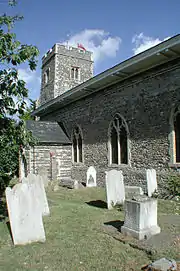Milton-next-Gravesend
Milton-next-Gravesend is an ecclesiastical parish in the north-west of Kent, England.

History
Feudal ownership of land in the parish was the subject of a legal action of 1076, Abbot Scotland v Hamo the Sherrif [sic], seeing St Augustine's Abbey, Canterbury take back its stake in ownership.[1]
Neighbouring Gravesend became a town under Royal Charter in the 13th century including Milton. The Church of England's founding was heralded by Henry VIII's split with Rome and the Dissolution of the Monasteries by which all of the abbots were retired and their institutions' endowments such as in this parish were confiscated from them.
Much of the population was, until about the 1840s scattered in rural farmhouses, country houses and cottages or those living along the east side of the High Street so not in Gravesend parish. The boundary between the two parishes is centred up Gravesend town High Street (which puts the old Town Hall in Milton, not Gravesend) then Windmill Street and Singlewell Road. Just as Northfleet developed to the west of Gravesend so decennial censuses record this parish saw an almost fourfold increase in population between 1831 and 1901 (from 4,348 to 9,256, in 1851, to 15,534 in 1901).[2] In the next ten year census the number of houses slightly increased and occupation rates; the population next stood at 14,994.[2]
| Employers and Professionals | 108 |
| Middling Sorts | 287 |
| Labourers and Servants | 511 |
| Others | 96 |
Churches
Two churches co-exist: the ancient parish church, dedicated to St Peter and Paul (at 51°26′21″N 0°23′08″E) at the heart of the old settlement;[4] and Christ Church at the western end of the parish built in 1856 when the town of Gravesend began to grow eastwards.[5] In other faith centres, the parish has the more protestant place of worship St Paul's United Reformed Church and two small independent churches/chapels.
St Peter and St Paul saw five of its bells cast in 1656 by John Hodson, a treble was added in 1810 (cast by Thomas Mears II) and the ring was augmented to 8 by two new trebles in 1930 (cast by Mears & Stainbank). The tenor is just under 12 long cwt (1,300 lb or 600 kg), tuned to F#.[6]
Notable people
- Sarah Baker (c1735-1816), actress and theatre manager born here
References
- 'Houses of Benedictine monks: The abbey of St Augustine, Canterbury', in A History of the County of Kent: Volume 2, ed. William Page (London, 1926), pp. 126-133. British History Online http://www.british-history.ac.uk/vch/kent/vol2/pp126-133 [accessed 28 February 2020].
- Vision of Britain - Total Population, retrieved 28 February 2020
- http://www.visionofbritain.org.uk/unit/10222904/cube/SOC1831
- The History of St Peter and St Paul:The Paraish Church of Milton next Gravesend Robert H Hiscock ISBN 1-901132-35-8
- Christ Church Milton-next-Gravesend:One Hundred and Fifty Years of Service, 1856-2006, Peter D Shearan BA (publisher) ISBN 978-0-9552570-0-1
- "Love's Guide". Archived from the original on 16 October 2004. Retrieved 14 September 2011.
External links
Milton Church - Official website for the Church of England ecclesiastical parish of Milton-next-Gravesend miltonchurch.org.uk
